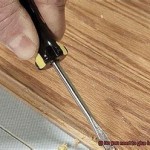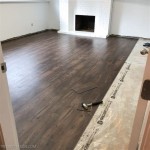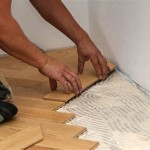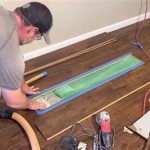Handsed Laminate Wood Flooring: A Comprehensive Guide
Handsed laminate wood flooring represents a specific type of laminate flooring that emphasizes a handcrafted, distressed, or textured appearance. The term "handsed" suggests a level of detail and artistry that mimics the look of real hardwood floors that have been worked by hand. This aesthetic choice has gained considerable popularity as homeowners seek the warmth and character of natural wood without the associated cost and maintenance complexities.
Laminate flooring, in general, is a multi-layer synthetic flooring product fused together through a lamination process. It simulates the appearance of wood using a photographic applique layer under a clear protective layer. Handsed laminate takes this simulation a step further by incorporating textures and patterns that replicate the subtle imperfections, grain variations, and surface treatments often found in hand-scraped or reclaimed hardwood. This results in a floor that is visually richer and more closely resembles authentic wood.
The manufacturing process for handsed laminate flooring involves several key steps. First, a high-density fiberboard (HDF) core provides structural stability. This core is typically made from recycled wood fibers and resin, compressed under high pressure. On top of the HDF core is the decorative layer, which is a high-resolution photograph of wood. Advanced printing techniques are used to create a realistic image of various wood species, including oak, maple, hickory, and walnut. The handsed effect is achieved through embossing-in-register (EIR) technology, where the texture aligns perfectly with the printed pattern, enhancing the realism of the wood grain.
Finally, a clear protective wear layer is applied to the surface. This layer is typically made of melamine resin and contains aluminum oxide particles for increased scratch resistance. The thickness of this wear layer is a crucial factor in determining the durability of the laminate flooring. A thicker wear layer offers greater protection against wear and tear, making the flooring more suitable for high-traffic areas.
Advantages of Handsed Laminate Wood Flooring
Handsed laminate flooring offers several significant advantages compared to both real hardwood and other types of flooring. These benefits contribute to its widespread adoption in residential and commercial settings.
One of the primary advantages is cost-effectiveness. Laminate flooring is generally less expensive than solid hardwood, engineered hardwood, or luxury vinyl planks. The lower material cost, combined with potentially lower installation costs, makes handsed laminate an attractive option for budget-conscious homeowners. This affordability allows individuals to achieve the look of high-end wood flooring without a significant financial investment.
Durability is another key benefit. The wear layer on handsed laminate is designed to withstand heavy foot traffic, scratches, stains, and fading. This makes it a practical choice for households with children and pets. Laminate flooring is also resistant to dents and impacts, which can be a common issue with softer wood species. The durability of handsed laminate ensures that the floor will maintain its appearance for many years, even under demanding conditions.
Ease of maintenance is a further advantage. Laminate flooring is relatively easy to clean and maintain. Regular sweeping or vacuuming is typically sufficient to remove dirt and debris. For spills and stains, a damp mop with a mild cleaning solution is all that is needed. Unlike hardwood, laminate flooring does not require waxing, polishing, or refinishing. The low-maintenance nature of handsed laminate makes it a convenient choice for busy homeowners who want a beautiful floor without the demanding upkeep requirements.
Key Considerations When Selecting Handsed Laminate Flooring
Choosing the right handsed laminate flooring involves careful consideration of several factors to ensure satisfaction with the final result. These considerations include the wear layer thickness, AC rating, color and style, and installation method.
The wear layer thickness is a critical factor in determining the durability of the flooring. Wear layers are measured in millimeters, and a thicker wear layer provides greater protection against scratches, scuffs, and stains. For residential applications, a wear layer of 8mm or higher is generally recommended. For commercial applications or high-traffic areas, a wear layer of 12mm or higher may be necessary. Selecting a laminate with an appropriate wear layer will ensure that the floor can withstand the intended use and maintain its appearance over time.
The AC (Abrasion Class) rating is another important consideration. The AC rating is a standardized test that measures the flooring's resistance to abrasion, impact, and staining. Laminate flooring is typically rated from AC1 to AC5, with AC1 being suitable for light residential use and AC5 being suitable for heavy commercial use. For most residential applications, an AC3 or AC4 rating is sufficient. For commercial applications, an AC5 rating is recommended. Choosing a laminate with an appropriate AC rating will ensure that the floor can withstand the expected level of wear and tear.
The color and style of the handsed laminate should complement the overall aesthetic of the room. Handsed laminate is available in a wide range of colors, patterns, and textures to mimic various wood species and styles. Consider the existing decor and the desired look and feel when selecting the color and style. Lighter colors can make a room feel more open and airy, while darker colors can create a more warm and inviting atmosphere. The handsed texture should also be considered. Some laminates have a subtle texture, while others have a more pronounced, distressed appearance. Choose a texture that complements the overall style of the room.
The installation method is another crucial consideration. Most handsed laminate flooring is installed using a click-lock system, which allows the planks to be easily snapped together without the need for glue or nails. This makes installation relatively straightforward, even for DIYers. However, proper preparation of the subfloor is essential for a successful installation. The subfloor should be level, clean, and dry. Any imperfections in the subfloor can telegraph through the laminate flooring, resulting in an uneven or unstable surface. If the subfloor is not properly prepared, it may be necessary to hire a professional installer to ensure a proper installation.
Maintenance and Care of Handsed Laminate Wood Flooring
Proper maintenance and care are essential to preserving the beauty and longevity of handsed laminate wood flooring. While laminate is generally low-maintenance, following a few simple guidelines can help to ensure that the floor remains in good condition for many years.
Regular cleaning is the most important aspect of laminate flooring maintenance. Sweep or vacuum the floor regularly to remove dirt, dust, and debris. Use a soft-bristled broom or a vacuum cleaner with a hardwood floor attachment to avoid scratching the surface. For spills and stains, wipe them up immediately with a damp cloth or mop. Avoid using abrasive cleaners or scouring pads, as these can damage the wear layer. A mild cleaning solution specifically designed for laminate flooring can be used for tougher stains.
Protecting the floor from scratches and dents is another important consideration. Use furniture pads under the legs of chairs, tables, and other heavy objects to prevent scratches. Avoid wearing shoes with sharp heels, as these can dent the surface. Place mats or rugs in high-traffic areas, such as entryways and hallways, to protect the floor from wear and tear. Exercise caution when moving heavy objects, and consider using moving blankets or dollies to prevent damage.
Controlling humidity levels is also important. Laminate flooring can expand and contract in response to changes in humidity. Excessive humidity can cause the planks to swell and warp, while excessive dryness can cause them to shrink and crack. Maintain a consistent humidity level in the home by using a humidifier or dehumidifier, as needed. Avoid exposing the floor to excessive moisture, such as from leaking appliances or standing water. Promptly address any water damage to prevent long-term problems.
Avoid using steam cleaners on handsed laminate flooring. While steam cleaners are effective for cleaning many types of flooring, they can damage the wear layer of laminate flooring. The high heat and moisture can penetrate the surface and cause the planks to swell or delaminate. Instead, use a damp mop with a mild cleaning solution to clean the floor.
Environmental Considerations of Handsed Laminate Flooring
The environmental impact of flooring choices is an increasingly important consideration for consumers. Handsed laminate flooring can be a relatively environmentally friendly option, particularly when compared to some other flooring materials, but understanding the factors that contribute to its sustainability is essential.
Many laminate flooring products are made with recycled content. The HDF core, which forms the bulk of the laminate flooring, is often made from recycled wood fibers. This helps to reduce the demand for virgin wood and divert waste from landfills. Look for products that are certified by organizations such as the Forest Stewardship Council (FSC), which ensures that the wood used in the flooring is sourced from responsibly managed forests.
The manufacturing process for laminate flooring can be relatively energy-efficient. The lamination process itself requires less energy than the production of some other flooring materials, such as hardwood. However, it is important to consider the overall environmental impact of the manufacturing process, including the sourcing of raw materials, transportation, and waste disposal.
Low-VOC (Volatile Organic Compound) emissions are an important consideration for indoor air quality. Some laminate flooring products can emit VOCs, which are chemicals that can contribute to indoor air pollution. Look for products that are certified by organizations such as GREENGUARD, which ensures that the flooring meets strict standards for low VOC emissions. Choosing low-VOC laminate flooring can help to improve indoor air quality and create a healthier living environment.
The durability of laminate flooring contributes to its sustainability. Because laminate flooring is resistant to wear and tear, it is less likely to need to be replaced as frequently as some other flooring materials. This reduces the demand for new materials and minimizes waste. Proper maintenance and care can further extend the lifespan of laminate flooring, making it a more sustainable choice over the long term.
In conclusion, handsed laminate wood flooring offers a compelling combination of aesthetic appeal, durability, affordability, and ease of maintenance. By carefully considering the factors outlined above, homeowners can select the right handsed laminate flooring to create a beautiful and functional space that meets their needs and preferences.

Water Resistant Wood Floor Economic Portable Laminate Flooring China Laminated Made In Com

Hand Applicator

Water Resistant Wood Floor Economic Portable Laminate Flooring China Laminated Made In Com

Laminate Flooring The Home Depot

Fastcap Sdrollerpro Handheld Laminate Edge Roller W Rubber And Steel Wheels Com

Water Resistant Wood Floor Economic Portable Laminate Flooring China Ac5 Walnut Color Made In Com

Water Resistant Wood Floor Economic Portable Laminate Flooring China Ac5 Walnut Color Made In Com

Water Resistant Wood Floor Economic Portable Laminate Flooring China Laminated Made In Com

Laminate Flooring The Home Depot

Vinyl Vs Laminate Flooring Which Is Better Lx Hausys
Related Posts








